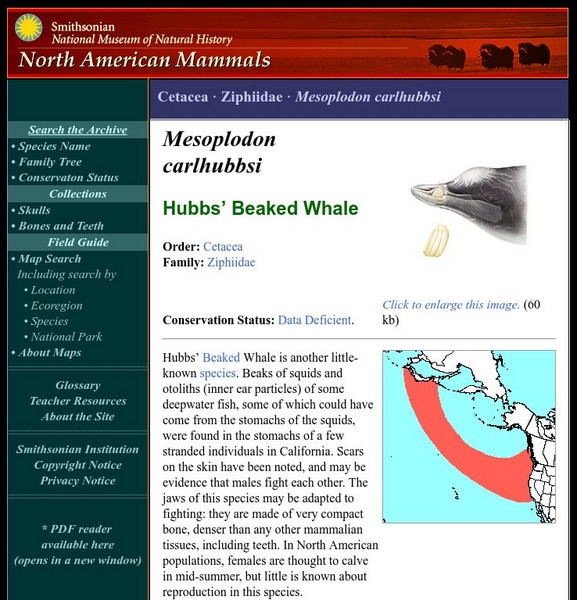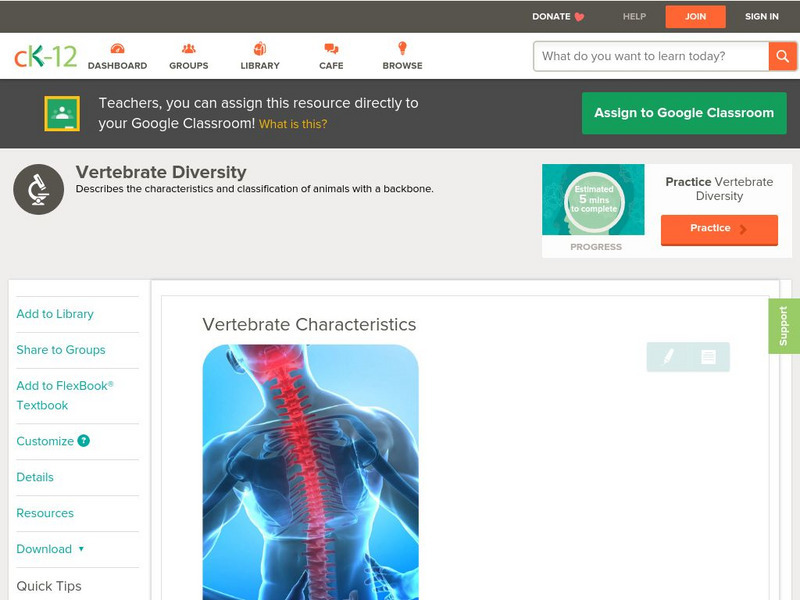Hi, what do you want to do?
Smithsonian Institution
National Museum of Natural History: American Mammals: Harbor Porpoise
Large numbers of harbor porpoises are caught in fishing nets, because the porpoises feed on schooling fish such as herring and mackerel, in relatively shallow coastal waters. They are also affected by increasing pollution in coastal...
Smithsonian Institution
National Museum of Natural History: American Mammals: Hubbs's Beaked Whale
Hubbs's beaked whale is another little-known species. Beaks of squids and otoliths (inner ear particles) of some deepwater fish, some of which could have come from the stomachs of the squids, were found in the stomachs of a few stranded...
Smithsonian Institution
National Museum of Natural History: American Mammals: Pacific White Sided Dolphin
Before the United Nations established a moratorium on the use of high seas drift nets in 1993, Pacific white-sided dolphins were frequently caught in the nets of Japanese and Korean squid fisheries. Today the species is better protected,...
Smithsonian Institution
National Museum of Natural History: American Mammals: White Beaked Dolphin
White-beaked dolphins have similar habits to Atlantic white-sided dolphins and live in similar cold-water regions of the North Atlantic. They eat fish, squid, octopus, and crustaceans. Learn more about the Lagenorhynchus albirostris,...
Smithsonian Institution
National Museum of Natural History: American Mammals: True's Beaked Whale
Found along the North American coastline from Nova Scotia to the Bahamas, True's beaked whale also inhabits temperate waters off the coast of Europe, and there are records of the species from near Australia and South Africa. Squid beaks...
Smithsonian Institution
National Museum of Natural History: American Mammals: Northern Right Whale Dolphin
With no dorsal fin, a slender body shape that tapers steadily toward the tail, and small flippers and flukes, the northern right whale dolphin appears to be built for speed. It has been clocked at 34 km per hour and can dive as deep as...
Biology Pages
Kimball's Biology Pages: Animal Circulatory Systems
This page has information on different types of animal circulatory systems. Scroll to the bottom of the page to find out about mammals.
NSTATE
Texas State Symbols
Here is a complete list of the Texas state symbols, including their year of adoption. Click on one to be taken to a page with more information and a picture.
Other
State of Mississippi: State Symbols
Here you'll find great information on the symbols for the state of Mississippi. Gives date of adoption, colorful pictures, and other important information about each symbol.
Enchanted Learning
Enchanted Learning: Mississippi
This site has a colorful display of information about Mississippi. It contains a map, pictures, a list of state symbols, and links to related information.
NSTATE
Michigan State Symbols
Learn about the symbols of the state of Michigan. Click on the word to be taken to a picture and information about the symbol, including when it was adopted.
Defenders of Wildlife
Defenders of Wildlife: Keep America's Tuna Dolphin Safe
This site not only contains fact sheets on the bottlenose, spinner, and spotted dolphins, but also examines the whole issue of dolphin conservation. You will learn how tuna fishing is hazardous to dolphins and how eating tuna can be...
CK-12 Foundation
Ck 12: Life Science: Chordates
[Free Registration/Login may be required to access all resource tools.] Did you know that fish, amphibians, reptiles, birds, and mammals are all related? They are all chordates. Chordates are a group of animals that includes vertebrates,...
Environmental Education for Kids
Eek!: Environmental Education for Kids
This site provides illustrations, descriptions, and species of amphibians, birds, fish, insects, invertebrates, mammals, reptiles, and endangered species.
CK-12 Foundation
Ck 12: Life Science: 10.2 Vertebrate Diversity
Learn about the characteristics and diversity of vertebrate animals.
DLTK
Kid Zone: Animal Classes
A comprehensive and colorful site that lists the various classes of animals with pictures and descriptions.
Other
Ocean Oasis: Field Guide
Ocean Oasis is a giant-screen film that depicts Mexico's Sea of Cortes and the Baja California desert. This companion site features much of the information the film has, such as beautiful images of animals, water, and land that have...
ClassFlow
Class Flow: Animal Classification
[Free Registration/Login Required] This interactive flipchart examines characteristics of each animal family (mammals, birds, reptiles, amphibians, and fish) It contains an assessment at the end which can be used with Activotes.
Environmental Education for Kids
Eek!: Life as a Wildlife Biologist
This site describes the skills needed for a career in Wildlife Biology. Includes link to a quiz that tests the student's knowledge of Wildlife issues.
Other
Hillfield Strathallan College: Evolution of Mammalian Circulation
An overview of the evolution of modern mamallian circulation. This is a good site since it puts the circulation found in reptiles in perspective. Compares it to systems in fish and mammals.
Other
Webucate: Free Multimedia Resources for Education
A labor of love created by a school in Great Britain. This is a well-organized image gallery with photos and other resources presented by topic, e.g., animals, places in the US, science, sports, etc. Though nothing to compare with a...
ClassFlow
Class Flow: Vertebrate Flipchart
[Free Registration/Login Required] This flipchart introduces students to vertebrates and provides pictures and information on the different types of vertebrates including their characteristics, their physical and environmental needs, and...
CK-12 Foundation
Ck 12: Life Science: Vertebrate Characteristics
[Free Registration/Login may be required to access all resource tools.] Vertebrates are animals with backbones. These include fish, amphibians, reptiles, birds, and mammals. Learn more about vertebrate characteristics in this learning...
ClassFlow
Class Flow: Animal Classification
[Free Registration/Login Required] This is a flipchart for first graders to learn about mammals, fish, birds, amphibians and reptiles.
























